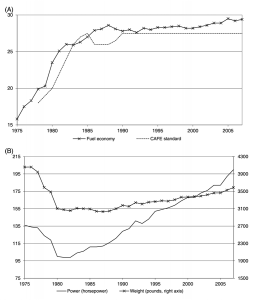
Trends in Fuel Economy, Power, and Weight (A) Fuel Economy and the CAFE Standard for Cars, 1975–2007 (MPG); (B) POWER AND WEIGHT OF CARS, 1975–2007.
Source: US Environmental Protection Agency. 2007. Light-Duty Automotive Technology and Fuel Efficiency Trends: 1975 through 2007. 420-R-07-008
In the first of a two-part series, RFF Fellow Joshua Linn explains how vehicle manufacturers respond to tightening fuel economy standards. Click to read the second installment.
Though the Corporate Average Fuel Economy (CAFE) standards have been regulating the fuel economy of US vehicles since 1978, the levels of the standards were pretty much flat for more than 20 years after they fully took effect. It wasn’t until the passing of the Energy Independence and Security Act of 2007, which was drafted following a period of intense debate, that the first major changes to CAFE standards were enacted.
Since then, the standards have been revised and now they jointly regulate fuel economy and greenhouse gas emissions. The new standards are tightening steadily—between 2005 and 2025 the average fuel economy of new passenger vehicles will have roughly doubled, reducing gasoline consumption and greenhouse gas emissions dramatically. Much of the public, including many industry analysts, believes that tighter standards will cause manufacturers to add technology that will dramatically increase the cost of producing the vehicles, and that much of these costs will be passed on to consumers.
But this belief is based on an overly simplified view of the vehicles market. In fact, power train efficiency has improved steadily during the past several decades. By efficiency, I mean the amount of useful mechanical energy derived from a unit of fuel. There is a technical tradeoff between fuel economy, horsepower, weight, and other vehicle characteristics. So, when manufacturers adopt technology that increases power train efficiency, they can decide how much of the efficiency improvement is devoted to raising fuel economy, as opposed to improving horsepower or other attributes. The figure below shows that when the standards were flat, from 1985 to 2007, the fuel economy of cars sold by US-based manufacturers was also pretty much flat. But that doesn't mean that manufacturers weren't adopting technology—in fact, they were consistently improving power train efficiency and using those improvements to raise horsepower and vehicle weight (and size), rather than fuel economy (see figure).
So what do manufacturers do when fuel economy standards tighten, as they have been since 2005 for light trucks and since 2011 for cars? We would expect manufacturers to continue adopting new technology just as they have been, except that rather than using all of its advances to improve horsepower and other vehicle attributes, they would use more to raise fuel economy than if the standards had remained constant. We might also expect that rising standards would cause manufacturers to adopt technology (and innovate) more quickly than they would have otherwise.
The point is that regulating fuel economy affects not just vehicle costs and fuel economy—as the conventional view maintains—but other characteristics as well. This effect is only apparent when we account for the steady technology adoption that has occurred both without and with tightening standards over the past four decades or more.
If this is the right way to think about the standards, we should see manufacturers changing characteristics and adopting more technology in response to the recent regulatory changes. In the second installment of this series, I will examine how recent standards have affected the type and rate of technology adoption in new vehicles.





